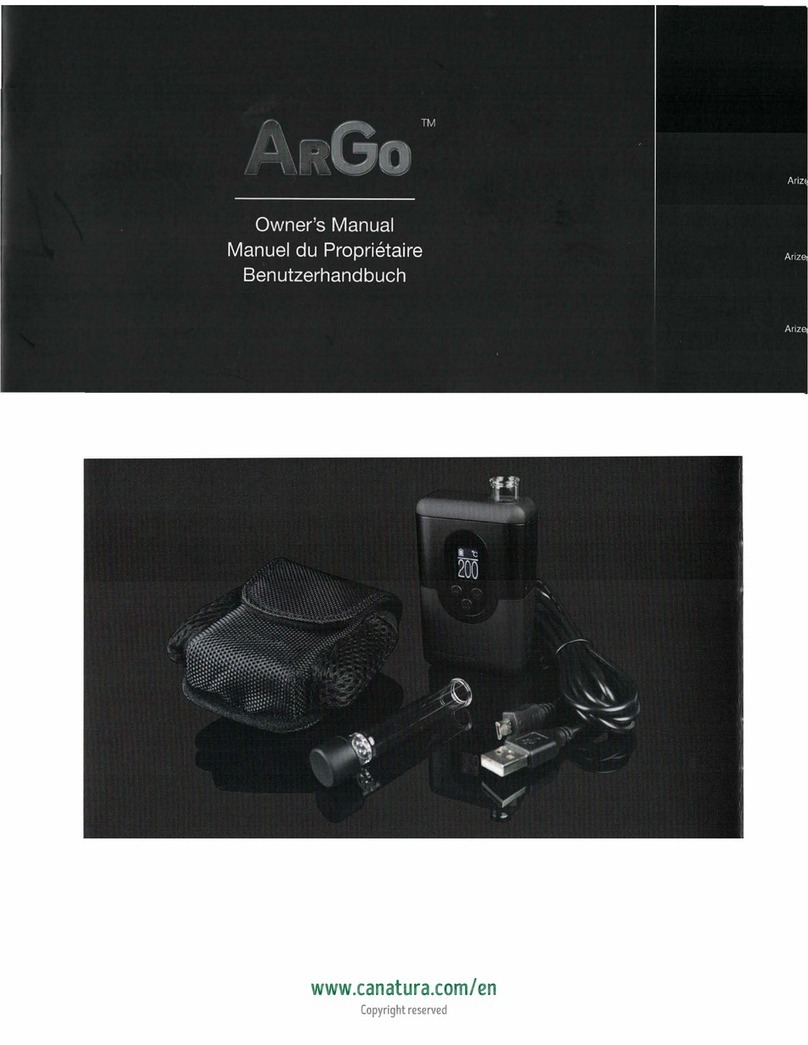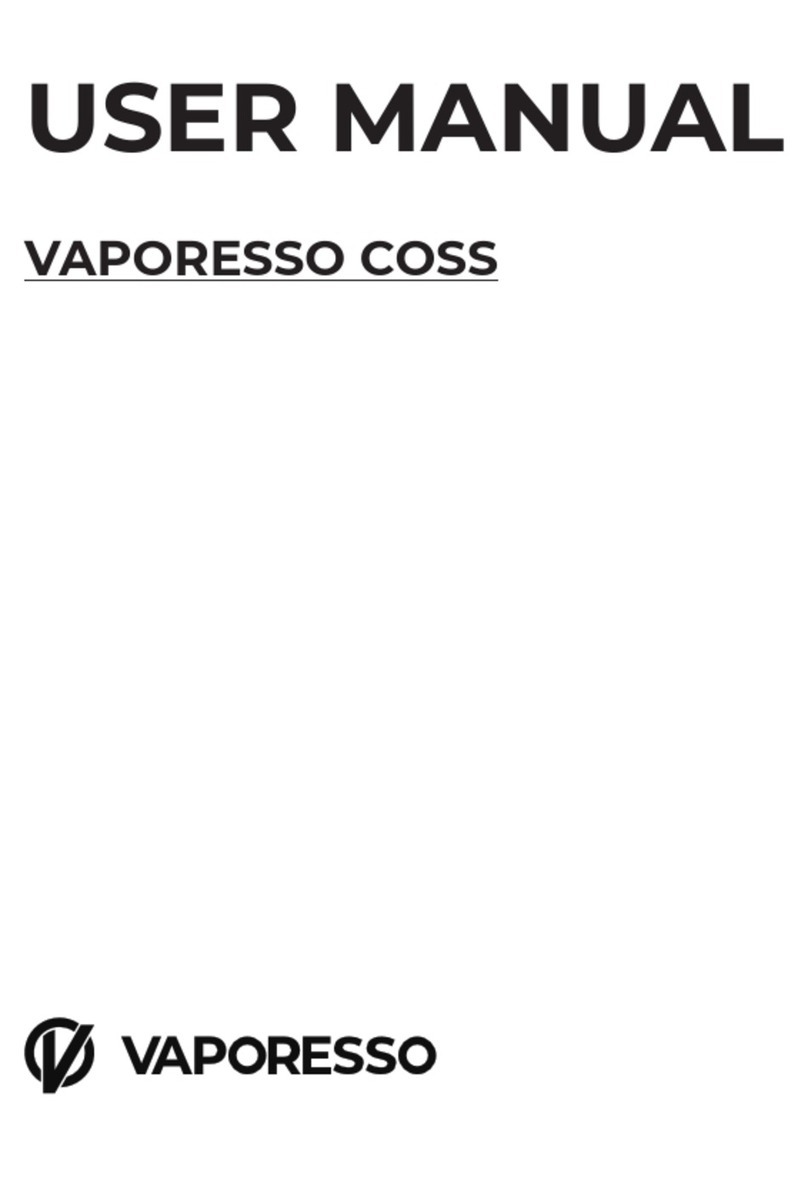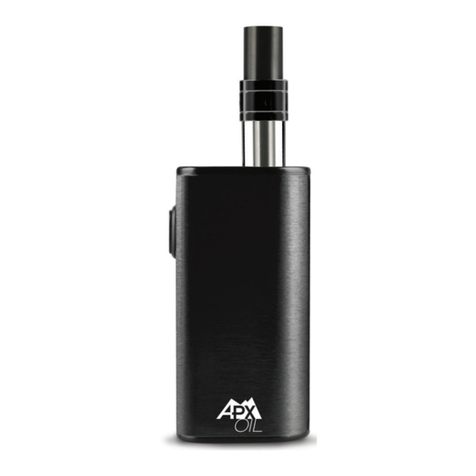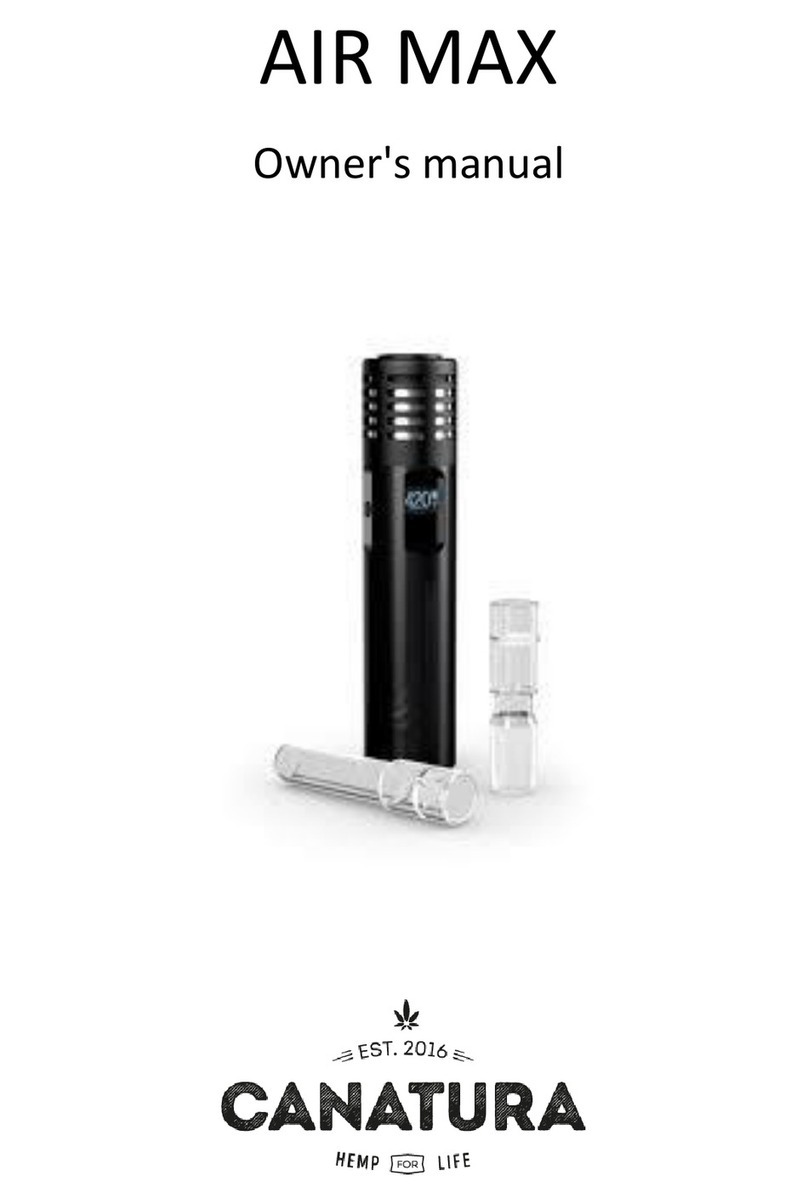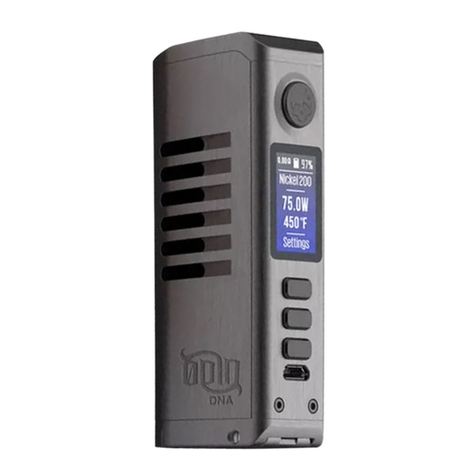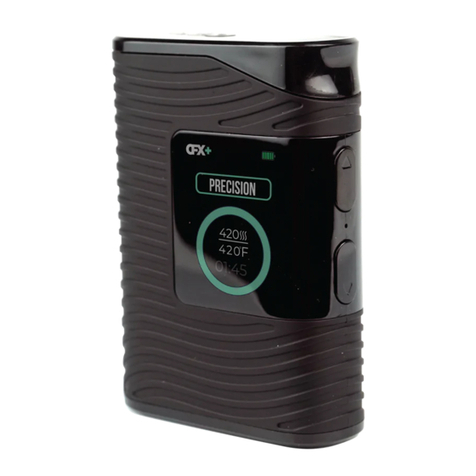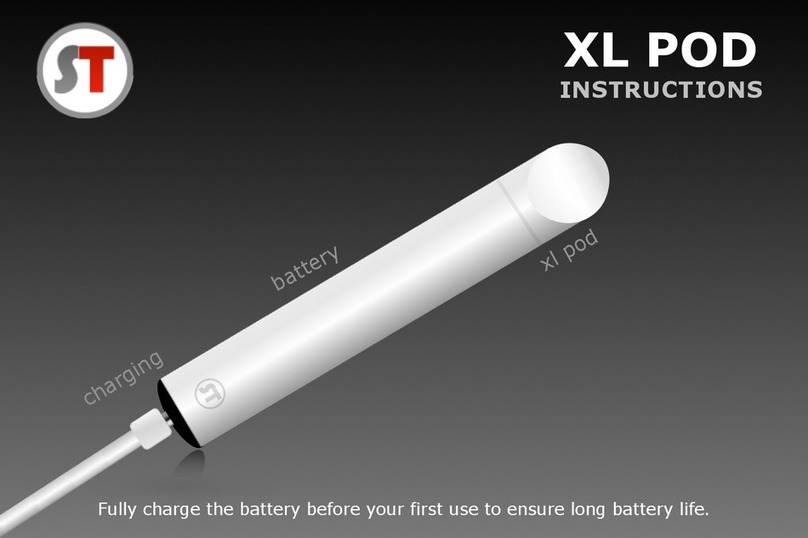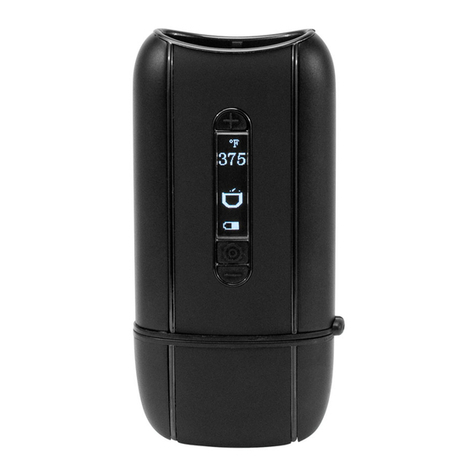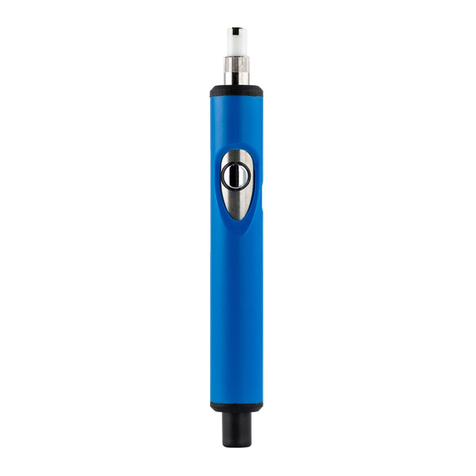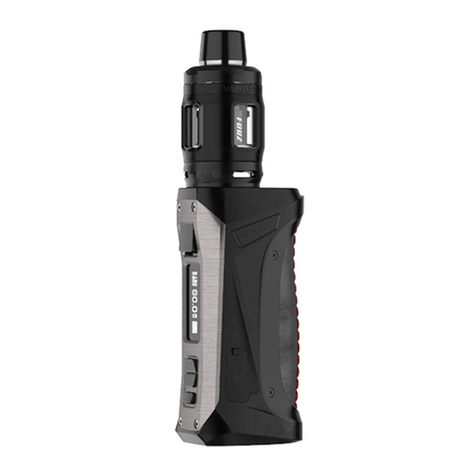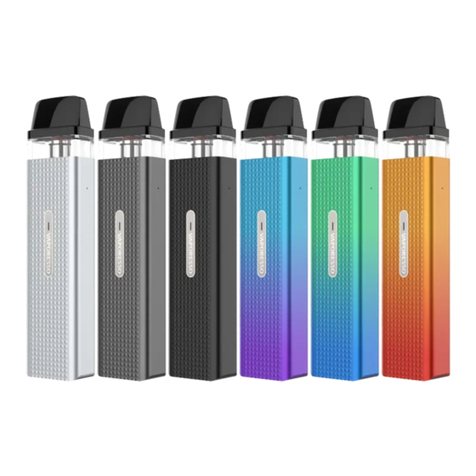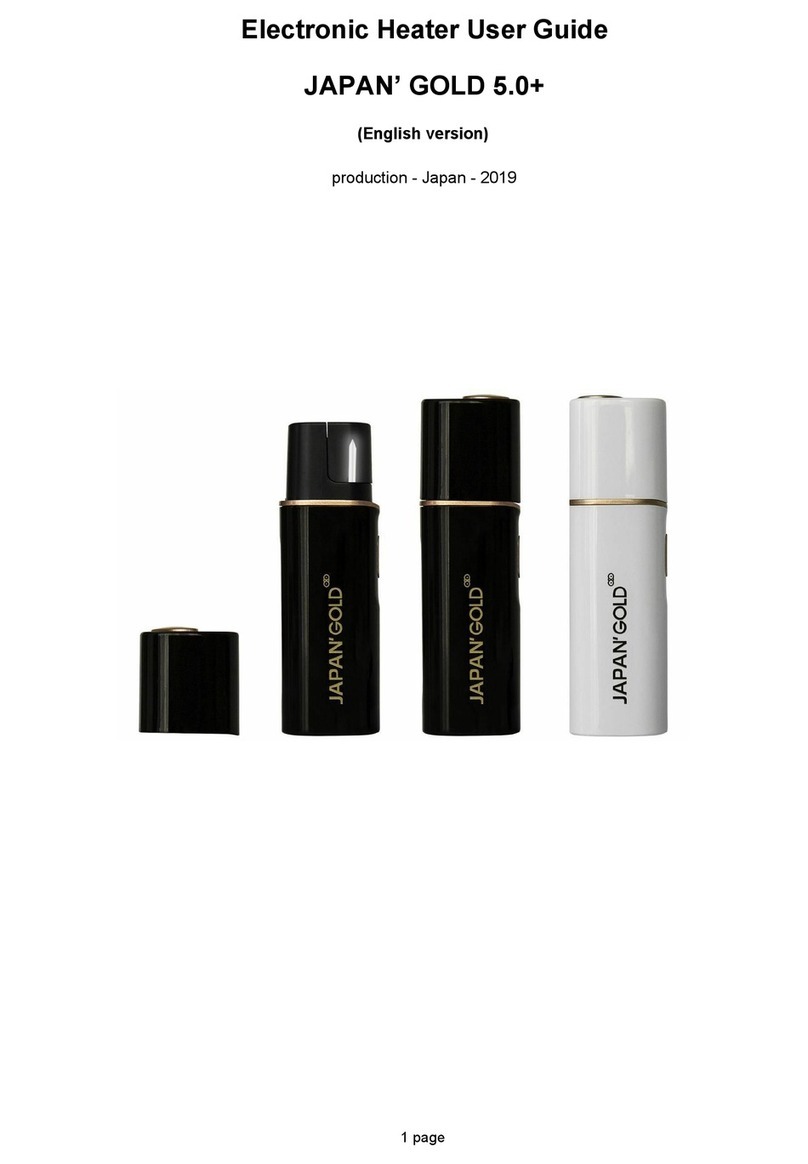SPECS EBE-1 User manual

EBE-1
Electron Beam
Evaporator
1.11

All rights reserved. No part of this manual may be reproduced
without the prior permission of SPECS GmbH.
ser manual for the Electron Beam Evaporator EBE-1.
Version 1.11 dated at 18 March 2008.
SPECS order number for this manual: 78 000 155
EBE-1
SPECS GmbH - Surface Analysis
and Computer Technolo y
Voltastrasse 5
13355 Berlin
GERMANY
PHONE:+49 (0)30 46 78 24 -0
FAX: +49(0)30 4 64 20 83
http://www.specs.de

Chapter
T Table of Contents
1 Introduction 1
1.1 Overview.....................................................................................1
1.2 Rods and Crucibles......................................................................1
1.3 Safety Instructions......................................................................2
2 Inspection 3
3 Installation 5
3.1 Connections.................................................................................5
3.2 Linear Motion Thimble...............................................................6
3.3 Mounting rods and crucibles.....................................................6
3.4 Conditioning the filament.........................................................7
3.5 HV conditioning..........................................................................8
3.6 Setting up rod position..............................................................8
4 Operation 9
4.1 Operating the EBE-1 Shutter.....................................................9
4.2 Evaporation from Rod................................................................9
4.2.1 Starting evaporation.............................................................................10
4.2.2 Continuing evaporation........................................................................12
EBE-1

Table of Contents
4.2.3 Ending evaporation...............................................................................12
4.3 Evaporation from crucibles......................................................12
4.3.1 Crucible lids............................................................................................12
4.4 Operation with the Flux Controller.........................................13
4.4.1 Setting up Manual Control of the PID Controller................................14
4.4.2 Setting the Maximum and Minimum Output......................................15
4.4.3 Setting up Auto Control........................................................................16
4.4.4 PID and Controller Parameters..............................................................17
4.4.5 Safe operation tips................................................................................17
5 Maintenance 19
5.1 Replacing the filament.............................................................19
5.2 Making a new filament............................................................20
6 Specifications and Options 21
6.1 Physical......................................................................................21
6.2 Beam..........................................................................................21
6.3 Power Supply............................................................................22
6.4 Options......................................................................................22
7 Drawings 23
EBE-1

Chapter
1Introduction
1.1 Overview
The EBE-1 uses electron bombardment to produce intense localised heating. Rods
and/or small crucibles may be heated in this way. They are placed inside a ring filament
at ground potential. Electrons from the incandescent filament are attracted towards
the rod or crucible, which is held at high positive potential and must be electrically con-
ducting. By accelerating the electrons to 2 kV and allowing the emission of up to 200
mA of electron current, a total heating power of up to 400 W may be delivered into a
very small area creating extremely high power densities and allowing temperatures in
excess of 3500 oC to be reached. Material evaporated in rod form may be fed continu-
ously into the e-beam heating zone as it evaporates away. Lengths of up to 50 mm may
be evaporated.
1.2 Rods and Crucibles
Materials which are electrically conducting and develop a useful vapour pressure before
melting may be evaporated directly from their rod form. Perfect examples of such ma-
terials are chromium and carbon which both sublime as the temperature is increased, as
well as many refractory metals such as molybdenum and tungsten which develop use-
fully high vapour pressures before melting.
Materials which melt before reaching high enough evaporation temperatures will ball-
up on the end of the rod before eventually dripping off the rod. This balling effect can
be controlled in some borderline materials such as silicon where use of a 4 mm or 5 mm
EBE-1 1

Introduction
rod allows a stable ball to be formed and low evaporation rates to be sustained. Niobi-
um and may also be evaporated in this way although with 3-4 mm rods and also platin-
um but with 2 mm rods.
Materials which melt before developing useful partial pressures (such as aluminium or
gold) must be evaporated from a crucible, as must insulators, such as alumina. The cru-
cible material must be chosen to have a vapour pressure very much lower than that of
the material being evaporated. It should also not react with the evaporant.
Please contact SPECS for more information on material compatibility.
1.3 Safety Instructions
Beware!
This source and its associated power supplies contain lethally hi h volta es and
should not be used by anybody except trained, qualified personnel
Improper use may lead to serious injury or death.
Particularly hazardous are the hi h volta es associated with the e-beam
acceleration. The volta es may reach >4 kV peak and currents may reach >200
mA.
The cable is encased in robust anti-scuff protection.
HOWEVER, always inspect the cables before operation and do not operate the
source under any circumstances if the cables appear in any way dama ed, frayed
or loose.
Warnin
Before any electric or electronic operations please consult “SPECS Safety
Instructions” and follow them strictly.
Attention
Tests to be performed on the electronic unit are when the cover is removed.
Hazardous volta es are present. Only trained, qualified personnel are allowed to
perform this task.
2EBE-1

Chapter
2Inspection
Please inspect the EBE-1 on arrival for any damage that may have occured during trans-
port or for possible loose screws. Check that the filament is well centred on the axial
hole in the copper block. If not, it may be possible to adjust it although the filament
will be very brittle. It may need to be replaced. The clearance between the filament
and any fitted crucible or rod should be at least 2 mm. It may be necessary to make a
new filament with a diameter to suit that rod or crucible in use (see later section on fil-
aments).
The resistance from the centre pin of the MHV feedthrough (on the thimble) to ground
should be >20 M . The resistance between the centre pin of the ΩMHV feedthrough and
the rod holder should be <0.5 . The resistance between pins A and B on the four pinΩ
feedthrough should be <0.5 .The resistance between either of these pins on the fourΩ
pin feedthrough and ground should be >20 M . The resistance between the centre pinΩ
of the BNC feedthrough (on one of the angled ports) and ground should be >20 M .Ω
The resistance between the centre pin of the BNC feedthrough (on one of the angled
ports) and the flux electrode should be <0.5 .Ω
EBE-1 3

Chapter
3Installation
The evaporator may be installed according to normal HV handling procedures. For rod
evaporation the orientation is not important.
For crucible evaporation where the evaporant is molten at the evaporation temperat-
ure, an upward pointing orientation is preferred. Where the evaporator must be hori-
zontal, crucibles are available with lids, which close the crucible leaving only a small
hole through which the evaporant emerges. This allows small volumes of molten mater-
ial to be contained without spilling. For materials with very low viscosity it may be ne-
cessary to have the lid welded onto the crucible and to fill and refill the crucible
through the 1 mm hole in the lid to prevent seepage through the press fit lid seal.
3.1 Connections
The cable comprises a low voltage high current cable for the filament and a high
voltage low current cable for the HV. The HV cable is fitted with MHV connectors at
both ends. Plug these into the MHV sockets on the back of the power supply and on
the evaporator. A BNC connector for the flux electrode is situated on one of the angled
ports. Take care to attach the MHV cable to the correct feedthrough. The MHV feed-
through is always the one mounted on the linear motion thimble.
The filament cable is terminated in an IEC plug at the power supply end and a 4-pin
connector at the evaporator end. Plug these into their respective sockets. Mains power
is also fed to the rear of the power supply using a standard IEC connector.
For the flux controller it will be necessary to connect the ¼ ” jack on the back panel to
the corresponding jack socket on the controller.
EBE-1 5

Installation
Two 6 mm Swagelok water connections are provided. Although it is not critical, it is
preferred that the inlet water be applied to the axial Swagelok fitting and the water
outlet to the radial fitting.
The water temperature should about 20 oC but above the dew point for the environ-
ment in which the evaporator is used. A flow of at least 0.5 litre/minute is required.
3.2 Linear Motion Thimble
IMPORTANT
Check that the countersunk mountin screws are not loose and that they are well
seated into their countersunk holes, or the thimble mechanism will catch on them.
The linear motion thimble is a precision mechanism and should always be turned slowly
and gently by hand. At no time should excessive force be used. The total thimble mo-
tion is 50 mm. When fully compressed the ends of the knurled grip are no more than
half way across the heads of the M3 countersunk mounting screws. The fully extended
position is 25 mm further back than this.
The end stop in the compressive direction is in the evaporator. The end-stop in the ex-
tensive direction is built into the thimble. The end-stops should not be used as a matter
of routine. They are there only for “last resort” protection of the bellows.
The instrument may be put out of ali nment or dama ed if the end-stops are hit
too hard.
3.3 Mountin rods and crucibles
To mount crucibles or rods
(1) Drive the thimble so as to bring the molybdenum rod holder backwards far
enough to give access to the screws and mounting hole.
(2) Insert the crucible or rod. Rods can be up to 55 mm long allowing for 5mm in-
sertion length in the rod holder.
6EBE-1

Mounting rods and crucibles
(3) Secure the rod or crucible with the titanium screw. Just lightly pinch the rod
with the screw. It need be no tighter than this. Over-tightening should be
avoided to prevent the screw locking in place.
(4) Drive the rod holder forward while checking the alignment and looking for pos-
sible contact between the rod holder, rod or crucible and copper block or fila-
ment.
(5) The crucible should be driven forward to within ~2 mm of the top of the copper
cooling block. This ensures that the filament is situated around the middle of
the crucible. If necessary, bend the filament back a little. It is only necessary to
insert the crucible into the rod holder far enough for the first screw to secure it.
This improves the thermal isolation of the crucible and allows it to sit forward in
the filament.
(6) Rods should be positioned as described below.
3.4 Conditionin the filament
If the filament is being used for the first time, it should be heated slowly and the HV
voltage should be off. Raise the current to say 4 A. Allow it to stay at this current for a
few seconds, then turn the filament current off. Repeat this procedure, increasing the
current by 1 A each time. When 7 A is reached leave the filament on, while a keeping
an eye on the system pressure. If the pressures rises higher than is desirable, reduce the
filament current and wait for the pressure to drop before repeating the procedure.
After several minutes of combined time operating at 7 A the system pressure will cease
to rise and start gradually falling again. At this point the filament is conditioned but
the vacuum will continue to improve with use for some time.
The filament is conditioned in this way to limit the amount of filament drift which can
occur. Filament drift could cause it to move until it touches the rod or crucible in which
case it must be replaced again. Filament drift is reduced my minimising the amount of
adjustment of the filament after the grub screws which retain it have been tightened. If
at any point during the conditioning, the electron emission current is suddenly seen to
rise, even though the HV is set to zero, a short circuit may have occurred.
EBE-1 7

Installation
3.5 HV conditionin
When the high voltage is raised for the first time or the first time after baking or out-
gassing, the emission current may be seen to jump periodically. Small sparks may even
be seen or heard. Provided that the amount of time between these is generally increas-
ing and the strength of the sparks is gradually decreasing, such disturbances may be re-
garded as part of the normal conditioning process and can be ignored. They can occur
because of local outgassing causing brief arcing or because of small sharp edges leading
to field emssion. The resulting arc generally rounds off the sharp edge thereby elimin-
ating the problem.
3.6 Settin up rod position
Make sure the flux monitor cables are disconnected from the instrument before
carryin out the procedure below.
During outgassing there could be arcing to the flux electrode which would otherwise
damage the flux electronics.
Before evaporating with a rod for the first time, drive the rod into its fully forward pos-
ition using the thimble drive. The rod will now stick right through the evaporation
zone. Set the e-beam voltage for instance to 1000 V using the “beam control”. Set the
range switch to 20 mA. Slowly increase the filament current (see conditioning the fila-
ment if this is the first time) until the emission current reads 10 mA and read just the
“beam control” to maintain 1000 V as necessary. 10 W of power is now being dissipated
in the rod. The rod may be driven in and out if desired, to warm it throughout and out-
gas it. Higher powers may be used for higher temperature materials.
Now, gradually withdraw the rod. The emission current will stay constant and then sud-
denly begin to drop as the tip of the rod leaves the evaporation zone. Drive the rod 3
mm forward again (1 full turn of the thimble). This is the ideal position for evaporation
from rod and ensures that the electrons strike only the tip of the rod.
8EBE-1

Chapter
4Operation
The evaporator is capable of evaporatin a hu e ran e of materials from thicker
2mm rods of refractory materials requirin hi h e-beam powers to small crucibles
full of hi h vapour pressure material requirin very little power. For this reason
care must be taken not to exceed the power required for a particular material.
For all materials there will be a maximum physical achievable evaporation rate, which
will be reached when the local vapour pressure around the tip of the rod or mouth of
the crucible is high enough for the HV to generate an arc through the vapour. This will
be noticeable as a pulse in the emission current.
4.1 Operatin the EBE-1 Shutter
The shutter should be rotated gently by hand. Only 75 o of motion is required to open
and close it. The shutter is CLOSED at 0 o. The shutter is OPEN at 40 o
4.2 Evaporation from Rod
ENSURE THAT ALL THE CABLE CONNECTIONS HAVE BEEN MADE
Ensure the chamber pressure is ~10-5Torr(mbar) or less.
EBE-1 9

Operation
Set the beam and filament controls to zero. Turn the power supply on. The beam
voltage will be briefly seen rising and then fall back to around 180 V. This is a character-
istic of the power supply and not a sign of malfunction. Depending on component
availability this output voltage may not appear. In this case increase the HV setting until
it shows a few hundred volts.
Now increase the filament current. As the current passes ~4.5 A the 180 V will drop to
zero indicating rather usefully that the filament has reached electron emitting temper-
ature. The HV circuit now sees a load instead of open circuit and the driver can drop the
voltage to zero.
The beam voltage can now be gradually increased. As the beam voltage rises, the emis-
sion current will also rise. Emission current can be reduced by decreasing the filament
current and hence the filament temperature. To increase the emission current the fila-
ment current should be increased. However as the emission current rises, the beam
voltage will be seen to drop a little but it can be readjusted using the beam control.
Regulating the output voltage can mask certain physical phenomena of the evapora-
tion and lead to runaway effects, which are not seen until too late. Electronically stabil-
ised evaporation is best achieved by regulating the filament current from a deposition
rate signal. The filament temperature is effectively setting the impedance of the source.
By adjusting the filament current in conjunction with the Beam voltage it is possible to
get the desired combination of beam voltage and emission current. A voltage of 1-1.5
kV will be enough for most purposes. At least 1 kV is required to ensure adequate fo-
cusing of the electrons. 2 kV will only be required for the most high power and de-
manding applications.
4.2.1 Startin evaporation
When the rod or material to be evaporated is heated for the first time and also when
the instrument is being used for the first time, it is important to condition and outgas
both. Outgassing can cause brief local increases in pressure, which can cause a moment-
ary arc to occur. This will cause no damage. It can in some cases take some hours of op-
eration at low power to ensure the instrument is properly conditioned. A blown fuse in
the power supply is indicated by the fact that emission current cannot be obtained.
With the rod tip in the right position, the power can now be increased until the re-
quired evaporation rate is achieved.
10 EBE-1

Evaporation from Rod
Set the voltage to 1500 V and gradually increase the filament current in order to in-
crease the electron emission current. Allow the emission current to increase by just a
few mA at a time. Then wait a time to allow the temperature increase to stabilise.
It is very important that the power is not increased too quickly. If the power is increased
too quickly, it is possible to overshoot the desired operating position and possibly dam-
age the rod or even the evaporator. This can occur because as the electron beam power
is increased, the temperature of the rod increases, this in turn reduces the heat loss
from the filament, which increases the filament temperature and therefore the emitted
electron current and so the electron beam heating is further increased. To avoid this
runaway effect, allow plenty of time when warming up the rod for the temperature to
stabilise before further increasing the emission current.
In all cases it is desirable to have a quartz crystal microbalance to monitor the evapora-
tion rate. The monitor should be capable of making rate measurements and not just ac-
cumulated thickness and should have a resolution of 0.1 nm/s or better. It is only really
by monitoring the actual deposition rates that the required operating conditions can be
found.
As a general guide, thin 2 mm rods are likely to require emission currents in the range
10 mA -50 mA to achieve good evaporation rates. 200 mA applied to a 4 mm thick rod
of carbon will produce high deposition rates in the nm/s range. 90 mA of emission cur-
rent will be enough to evaporate a 4 mm rod of niobium at 0.01 nm/s.
IMPORTANT
The evaporator is capable of evaporatin a hu e ran e of materials from thick
rods of refractory materials requirin hi h e-beam powers to small crucibles full
of hi h vapour pressure material requirin very little power. For this reason care
must be taken not to exceed the power required for a particular material.
For all materials there will be a maximum achievable evaporation rate, which will be
reached when the local vapour pressure around the tip of the rod or mouth of the cru-
cible is high enough for the HV to generate an arc through the vapour. This will be no-
ticeable as a pulse in the emission current or in heavier cases by the blowing of an HV
fuse.
EBE-1 11

Operation
4.2.2 Continuin evaporation
As the tip of the rod evaporates it gradually recedes from the filament. This will cause a
drop in the emission current as the extraction field is effectively being reduced. If the
evaporation rate becomes too low, drive the rod forward using the thimble until the
emission current increases to the previous stable level. It should only require 1 mm to 2
mm of movement to achieve this. The time it takes before the rod must be driven for-
ward depends of course on the evaporation rates used and the thickness of rod being
evaporated but can range from hours for very low evaporation rates from thick rods to
just a minute or so for high rates from thin rods.
4.2.3 Endin evaporation
Turn off the filament and then the HV.
4.3 Evaporation from crucibles
The crucible should be positioned fully forward in the evaporation zone with the lid or
crucible rim just ~2 mm below the under surface of the copper block lid.
The material can now be evaporated by following the instructions above for evapora-
tion from rod taking care again to allow plenty of time for thermal equilibrium to be
reached.
4.3.1 Crucible lids
Note that using a lid on a crucible will reduce the available evaporation rate by a factor
of ~10. Lids are intended principally for retaining the contents when the evaporator
must be mounted horizontally or pointing downwards. They may also however be use-
ful when very low rate evaporation is required.
12 EBE-1

Operation with the Flux Controller
4.4 Operation with the Flux Controller
Figure 1: Front panel flux controller
The flux controller is suitable for controlling the evaporator whenever steady, stable
and long term evaporation can be achieved manually. Materials which spit, outgas er-
ratically, exhibit unstable evaporation or which need to be evaporated at very high
rates are unlikely to work well with the flux controller.
Evaporation from rod will work best at low evaporation rates, so that sufficient depos-
ition time is available before the rod is used up and needs to be driven forward again.
The flux controller converts the small current signal intercepted by the flux electrode
into a voltage in the range 0-10 V.
Connect the PID control unit to the power supply using the supplied cable with stereo
jack sockets. (Not available on display, only version without controller). Connect the
BNC input to the BNC feedthrough on the evaporator. Be sure not to confuse this with
the MHV feedthrough. The MHV feedthrough will be mounted on the linear motion
thimble, while the BNC feedthrough will be on one of the angled ports on the multi-
port adapter.
EBE-1 13

Operation
ENSURE BOTH THE POWER SUPPLY AND CONTROLLER ARE TURNED OFF WHEN THE
JACK SOCKETS ARE INSERTED.
The evaporation should first be established manually (set the PID controller to manual
control and then set the toggle switch to Auto, see section 4.4.1) before handing over
control to the flux controller. The Man/Auto switch has no function and is not connec-
ted when the display only model has been ordered. The PID unit in the flux controller
accepts a 0-10 V voltage at its input and adjusts its 0-10 V output as required to main-
tain the input voltage at the set-point level.
Having established the desired evaporation rate manually, the range and electrode bias
control should be adjusted to give a signal around 50 % of full-scale deflection.
The bias control should always be adjusted to at least a third of its travel or more in or-
der to get efficient measurement of the ion flux.
For good control it should now be apparent that the measured flux is directly related to
the e-beam power. Reducing the filament current and thereby the emission current
should cause a clear decrease in the flux current and vice versa. As a rod or crucible is
heated for the first time, the evolved gases will produce a measurable ion current,
which rises briefly but then falls again as the outgassing ceases. Ion current from true
evaporation will not behave in this way but will be related in a repeatable and stable
fashion to the e-beam power.
As a guide only (because the current will depend on the material, position of the rod or
crucible and evaporation rate), evaporation rates in the range of 0.1 Å/second will pro-
duce flux currents in the range 0.1-1 A.μ
Make a note of the measured flux current value at the desired evaporation rate. Make
a note of the filament current required to achieve the desired evaporation rate.
4.4.1 Settin up Manual Control of the PID Controller
DO NOT TURN ON THE MAIN POWER SUPPLY UNTIL THE PID CONTROLLER IS IN
MANUAL CONTROL AND THE OUTPUT SET TO ZERO.
14 EBE-1

Operation with the Flux Controller
To set “Manual control”, PID access must be set to F LL. The “Page” button is the left-
most button on the PID controller. The “Scroll” button is the next button from the left.
Then follow the up and down arrow buttons.
Press the “Page” button 8 times until “ACCS List” is displayed. Press the “Scroll” button
once until “Code 0” is displayed. se the up arrow button until “1” is selected. After a
brief pause the display will show “PASS”. Press “Scroll” once. “Goto Oper” will be
shown. Press up arrow once and “ACCS F LL” will be displayed. Press “Page” twice to
get the two rows of digits displayed. The upper digit is the measured value of flux cur-
rent and the lower value is the PID output (in Man mode) or the Set Point in Auto
Mode.
Now with F LL ACCESS set it is possible to select manual mode. Press “Scroll” twice and
“m-A” will be displayed on the upper line and “mAn” or “A TO” on the lower line.
se the arrow keys to select “mAn”. The controller is now in “MAN AL” mode and the
green light should be on. Press “Scroll” three times to get back to the display with the
measured value. The arrow keys can now be used to directly control the PID controller
output.
Set the Man/Auto switch to Auto.
4.4.2 Settin the Maximum and Minimum Output
Set the Set point on the PID controller to some value which is considerably greater than
the measured current value, this will ensure that the controller tries to provide maxim-
um output. Now set the maximum output of the controller to 30 %. Set the Man/Auto
switch to Auto. The power supply is now under the control of the PID controller which
will be trying to give full output in order to bring the flux current up to the required
level. But it will be prevented from doing so by the fact that the maximum output drive
is limited to 30 %.
Increase the Maximum Output setting of the PID controller in 5 % steps (smaller as the
required value is reached) until the filament current (and therefore the emission cur-
rent) is slightly higher than the value recorded during manual evaporation. Note if the
allowed filament current is too much higher than that required, the possible emission
current could be too high for the material being evaporated, causing rods to melt or
the crucible contents to boil. Be sure to check that the emission current at no time ex-
ceeds allowed limits for the material being evaporated.
EBE-1 15

Operation
The Minimum Output can now be set in a similar way by lowering the setpoint value to
well below the actual value displayed. The PID controller will now try to give minimum
output. Set the Minimum Output level of the PID controller to be such that the filament
current reached is ~1.5 A less than that required for evaporation. This will stop excess-
ive filament current swing and filament stress when the PID controller is adjusting the
filament control (especially during an auto-tune operation).
Put the controller back to “MAN AL” mode and re-establish the required evaporation
conditions and stability as before.
4.4.3 Settin up Auto Control
First set the PID controller to Man control if not already set. The green MAN light will
be glowing if in manual control mode. The arrow keys can now be used to directly con-
trol the PID controller output. Raise the output and watch the filament current on the
main power supply rise accordingly.
Set the HV to 1 kV and increase the filament current until emission current begins to be
seen (this can be seen on the HV supply and on the main power supply).
Carefully and slowly allow the material to come to thermal equilibrium. Adjust the fila-
ment current using the PID output as necessary to maintain stable emission. Once satis-
fied that operation is stable and the required evaporation rate has been reached press
“Scroll” once to get “SP xx” where “xx” is the value of the setpoint. Adjust this to be
the same as the measured value of flux which has been reached.
Press “Scroll” once more to get to the “m-A mAn” screen and use the arrow keys to se-
lect A TO.
The PID controller will now be in A TO control and will automatically adjust the fila-
ment current to maintain the flux current at the required value.
If stable control is not achieved it may be necessary to run the auto-tune function to es-
tablish new PID parameters. If control is still not sufficiently stable, the maximum out-
put of the PID controller should be gradually reduced (say 5 % at a time). At each de-
crease the control stability should be seen to improve. If the PID controller cannot bring
the flux up to the required set-point it will be necessary to increase the maximum out-
put setting of the PID controller.
16 EBE-1
Table of contents

